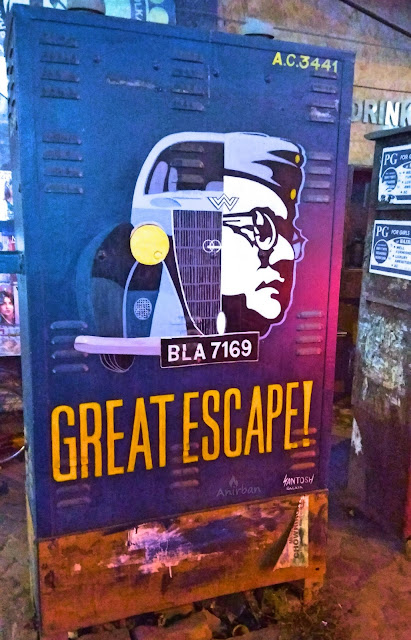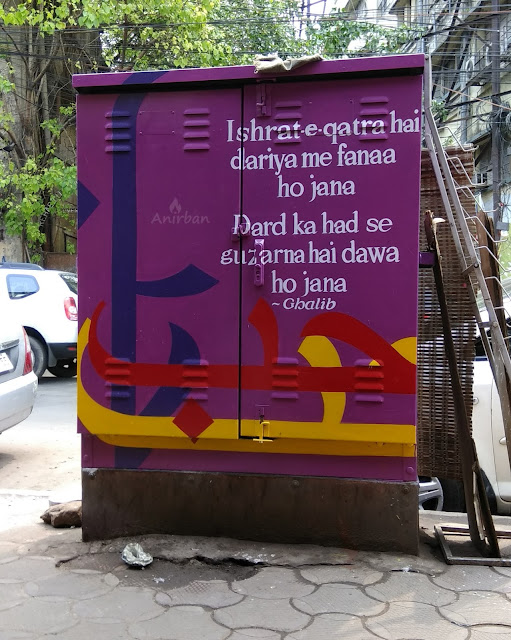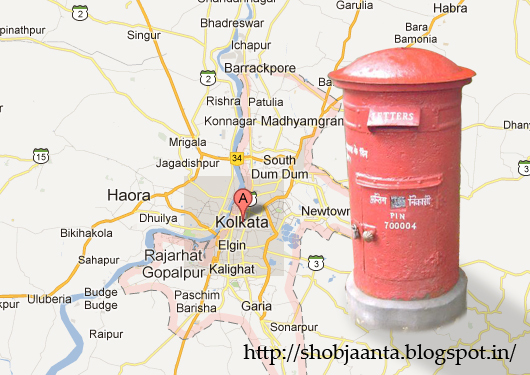Nelson Mandela once said "Our rich and varied cultural heritage has a profound power to help build our nation".
Kolkata, the city of Joy, is known as the culture capital of India, having a rich heritage and having a history of literary stalwarts, intellectuals, writers, artists, performers etc. We have so many historically and culturally significant places hidden in every nook and corner of the city that its becoming difficult to preserve them. It is our responsibility, as citizens, to do something that increases the awareness about these places and the famous people who lived there... and also beautifies the city at the same time.
 |
| Me posing with one of the CESC Feeder boxes that pays tribute to my Guru the Ace film maker, Story teller and what not... Academy award winner legendary Satyajit Ray. |
While visiting Netaji Subhash Chandra Bose's ancestral home in Kolkata's Bhawanipur, I came across a CESC's Electric junction box also known as feeder box, just outside the building, with a very beautiful mural of Netaji, in attractive blue, orange and Green colors, with the text "Netaji Subhash Ch. Bose Lived on 38/2 Elgin Road".
 |
| This was the first painted feeder box that I saw |
I was really impressed by this initiative as it is doing three main things, firstly it is reducing the Visual pollution because generally these junction boxes are covered with film Posters, and ads of what not. Secondly it is art educating the residents about the great people who stayed in the locality, Thirdly it is spreading awareness about ways in preserving our heritage.
I did some research and came to know that this is a heritage art project by Mr. Mudar Patherya, a heritage activist and conservationist, to pay respect and to commemorate some of the renowned Calcuttans.
 |
| Mr. Mudar Patherya; Source: Facebook |
Mr. Mudar, who runs a communications company called Trisys, is an alumnus of St. Xavier's Kolkata... He with his designer colleague Mr. Partha pratim roy did the Planning and created the Artworks.
 |
| RJ Roy with Mudar Patherya and Partho Pratim Roy; Source: Facebook |
The Artist/Painter Mr. Santosh Das from Salkia replicated those artworks on the electricity boxes and executed the plan. The project is being done with permission from CESC and is encouraged by Mr. Sanjiv Goenka himself. Mr. Patherya's dream is to transform all feeder boxes of CESC into "powerful" info-boxes of local legends with artistic impressions.
Anyone blessed with creativity and the ability to replicate the designs/ artworks into reality on the electric boxes can join the project. So here's a chance to do something for our city... Mr.Patherya posted details on how to connect with him in this Facebook post:
https://goo.gl/QbrMxH
Have a look at the ordinary CESC Feeder Boxes below... you will know how beautiful this initiative is... a noble cause to reduce visual pollution and spread awareness about the legends of our City of Joy... Kolkata.
 |
| The ordinary Feeder boxes or the CESC electrical junction Boxes... perfect example of visual pollution. |
The initiative that started from South kolkata's lake Temple Road, Sarat Chatterjee Avenue, Lake Avenue and SN Road Area has now reached places like Elgin Road where I saw Netaji's mural and Park Street. A lot more places are yet to be reached. So its high time that we do our bit to beautify the City of Joy... our own Kolkata.
Have a look at the Murals that I could Capture:
 |
| The words that kindled the flame of patriotism in Indian youth. |
 |
| Netaji created Azad hind Fauj with captured Indian soldiers to secure Indian independence from British rule |
 |
| Netaji Bhawan - Netaji's Ancestral Home on Elgin road, in Kolkata |
 |
| Netaji is "Still Alive" in the hearts of every Indian |
 |
| "Dilli Chalo" (On to Delhi) the call Netaji used to motivate INA. |
 |
| on 22nd August 1930 Netaji Subhas Chandra Bose was elected as the Mayor of Calcutta |
 |
| "Jai Hind", a salutation, slogan, and battle cry coined by Chempakaraman Pillai and Abid Hasan was used by Netaji to indicate patriotism towards India. |
 |
| Netaji was a master of disguise, He escaped from his house arrest in the historic Wanderer car with number "BLA 7169" |
 |
| The historic Wanderer car in which Sisir kr Bose drove his uncle Netaji Subhash Chandra Bose from Calcutta to Gomoh during the Great Escape of January 1941 is on display at Netaji Bhawan. |
 |
| The Mukherjee Commission concluded that while Bose was presumed dead given the many years that had passed, he did not die in the plane crash in Taipei in 1945. Instead the commission proposed that the crash was a ruse to allow Bose to escape with the knowledge of the Taiwan and Japanese governments of the time. This reminds me of the last dialog from Film Anand "Anand mara nahi... Anand marte nahi" |
 |
| "Jai Hind" : a slogan coined in a German Prisoner Of War camp by Netaji’s aide; To read the full story click here |
 |
| This Feeder Box dedicated to Shree Kanhaiyalal Sethia ji is also in the Elgin road area. Shree Kanhaiyalal Sethia, an eminent Rajasthani and Hindi poet, freedom fighter, social worker, reformer, philanthropist and environmentalist lived in Kolkata's Elgin Road area. He graduated from the Scottish Church College at the University of Calcutta. He breathe his last in Kolkata. |
There are a series of feeder boxes with Murals painted on them in Park Street too. I started capturing them from "The Asiatic Society".
 |
| Sir William Jones the Anglo-Welsh philologist, a scholar of ancient India and a puisne judge on the Supreme Court of Judicature at Fort William in Bengal, who founded "The Asiatic Society" |
 |
| Sir William Jones' Tomb in Park Street Cemetery |
 |
| Usha Uthup or DIdi as she is referred to, a versatile singer who has sung in more than thirteen Indian and eight foreign languages believes that she has a special connection with the city of Joy... and so do we Bengalis... |
 |
| Usha Uthup loves Kolkata so much that she wears a Bindi that has the initial letter of Kolkata in Bangla "ক" ("Ka") written on it. Here in this mural a song is written that she wrote/sang on Kolkata "Aaha Tumi Shundori kotow" (How beautiful you are Kolkata) |
 |
| Louis Banks an Indian film composer, record producer, jazz musician-keyboardist and singer. Proficient in genres like Indipop, modern progressive and contemporary jazz and Indo-jazz fusion stared his career as a drummer at the "Blue Fox Restaurant", a popular night club famous for its patronage of live western music. |
 |
| Pam Crain India' first and only jazz diva, who , in a remarkable career that began as a teenager, way back in the 1930's went on to become the jazz voice of India used to perform at Mocambo and Blue Fox at Park Street. |
 |
| Park Street's present official name, "Mother Teresa Sarani" was given by Kolkata Municipal Corporation in honour of Mother Teresa, who served the poor and needy people in Kolkata. |
 |
| Arathoon Stephen,an Armenian hotelier and real estate developer based in Calcutta (Kolkata), owned and developed many Kolkata institutions including the Empire Theatre, Queen Mansion, Stephen House, Stephen Court and the Grand Hotel |
 |
| The feeder box on the left celebrates the "Flurry's"... Open since 1927, an elegant thirties design tearoom serving Indian and European cakes and pastries. The one on the right Celebrates "Trincas" restaurant on Park street where Biddu started his career. Trincas that is more than 58 years old was once, and still is, a preferred hangout of celebrities from across the country, Trincas has hosted stars like Amitabh Bachchan, Shashi Kapoor and Rekha. |
 |
| Sky Room Restaurant set an example of excelence in the domain of continental cuisine. It closed in 29th Dec 1993 after a run of 36 years, but is still missed by it's patrons badly. They wish that the slogan used in Skyroom's advertisements "Let's go to Skyroom!" comes true again!! |
 |
| Surrendra Paul, a tea planter and the promoter of the Kolkata-based Apeejay Surrendra Group was also a visionary. His Park Hotel still remains a landmark of Kolkata. |
 |
| Someplace Else pulsates with performances by the city's best live bands dominating pub culture in Kolkata since its inception. It helped in reviving the glory of 50s and 60s through Live music. This place is so popular that even Bangla Band Chandrabindoo mentioned "Tantra" and "Someplace Else" in their popular song "Bramha Janen Gopon Kommoti" (ব্রহ্মা জানেন গোপন কম্মটি) |
 |
| Jit Paul is known as the person who defined Park street with having some
of the best landmarks of the street, like The Park, Flurys, Park
Mansions, Apeejay House, Apeejay School, Oxford Bookstore, The Tea Table
and Banyan Tree, under the Apeejay Surrendra Group. After Surrendra Paul’s sudden death, or rather murder on April 9, 1990, his wife Shirin Paul became chairperson of Apeejay group, and the business was managed by his brother Jit Paul. |
 |
| Park Street, officially known as the Mother Teresa Sarani and earlier as the Burial Ground Road, was laid out through what was once a deer park that belonged to Sir Elijah Impey, Chief Justice of the Supreme Court in Calcutta from 1773 to 1779, the man who sentenced Maharaja Nandakumar to death for forgery. |
 |
| There were bikes parked in front of the feeder box... this gentleman on the left removed the bikes for me to take pictures. People of Kolkata go the extra mile to help you. 😊 |
 |
| Father Henri Joseph Depelchin S.J. (Society of Jesus) was a Belgian Jesuit priest and missionary in India and Africa who Founded Saint Xavier's College in 1860... The oldest Indian Jesuit Institution... First autonomous college in Bengal. |
My next destination was south kolkata's Lake area from where Mr. Mudar Patherya started this Street art initiative of art-educating people on our rich heritage and culture.
 |
| Shri Bhagirath Kanoria, who lived at 10, Sarat Chatterjee Avenue, was one of the foremost reformist Marwari leaders, whose contribution to the nationalist movement and social upliftment, especially the upliftment of women is highly commendable. He will always be remembered for his philanthropic works. The book "The Marwari Heritage" tells us in details about his charity and philanthropy. |
Satyajit Ray lived at 3, Lake Temple Road, during the most prolific decade in his career. Thespian Soumitra Chatterjee then moved into the house Ray vacated when he moved to Bishop Lefroy Road in 1970.
 |
| House No.3, Lake Temple Road, where Satyajit Ray stayed for 11 years before moving to Bishop Lefroy Road in 1970 |
 |
| Satyajit Ray’s 'Nayak' turned 50 in the year 2016... the movie tried to reveal the darker elements of its star protagonist’s personality. One of the best films of this genre was made by Ray when he was staying in 3, Lake Temple Road. Nayak received "Special Jury Award" at Berlin International Film Festival in 1966 and "National Film Award for Best Feature Film in Bengali", in 1967 |
 |
| The story of "Devdas" is so popular that it has been made into films 17 times in various languages... The road "Sarat Chandra Avenue" has been named after Sarat Chandra Chatterjee, the author of "Devdas" |
 |
| Kaviguru Rabindranath Tagore's Short Story "Noshtow Neer" "নষ্টনীড়" ("The Broken Nest") was adapted into a Bengali film named "Charulata" (English Name "The Lonely Wife"), the name of the female protagonist of the story, by Satyajit Ray... The the binoculars in the mural are symbolic and reminds us of a scene in the film where Charulata, played by Madhabi Mukherjee, used to look at people on streets using her binoculars. |
|
 |
| Charulata, played by Madhabi Mukherjee, with her Binoculars |
 |
| "Parineeta" another classic bengali novel was also made into a Hindi film with the same name, by Pradeep Sarkar starring Vidya Balan, Saif Ali Khan, Sanjay Dutt and Rekha...was also authored by Sarat Chandra Chatterjee on whose name this road was named |
 |
| The music for the Bengali Song "Ei Raat Tomar Aamar" was composed by the most versatile Mr. Hemanta Mukherjee popularly known as Hemant Kumar in Hindi film industry. The same music was used by him for the popular Hindi song "ye nayan dare dare" picturised on Waheeda Rehman ji in the 1964 movie "Kohraa" (The Fog). Hemanta Mukherjee lived at 6, Sarat Chatterjee Avenue. |
 |
| "Feluda" The evergreen sleuth was the creation of Satyajit Ray. Ray wrote 38 stories with Feluda as the protagonist... out of these 3 stories were unfinished. Ray made two Films on feluda... Joi Baba Felunath (The Elephant God) being one of them, that he made in 1979, featuring Soumitra Chatterjee as feluda. Soumitra Chatterjee started living at 3 Lake Temple Road after Ray moved to Bishop Lefroy Road in 1970. |
 |
| Satyajit Ray, while staying at 3, Lake temple Road, made the Bengali Bengali fantasy adventure comedy film "Goopy Gyne Bagha Byne" (গুপী গাইন বাঘা বাইন) in 1969. The film was written and directed by Satyajit Ray and was based on a story by his grandfather Upendra Kishore Roychowdhury. |
 |
| The 1960 Bengali film Devi (দেবী) "The Goddess"... Directed by Satyajit Ray, that received National Award in 1960 was the story of a young woman, deemed as a goddess when her father-in-law, a rich feudal land-lord, has a dream/vision envisioning her as an avatar of Kali. A path-breaking film that shatters the age old spiritual practices... A film that was initially banned in India until the intervening of the then prime minister Nehru...The film starred Soumitra Chatterjee, Sharmila Tagore and Chhabi Biswas in Lead roles. During the making of this film Satyajit Ray was staying in his Lake Temple Road home. |
 |
| The CESC Electric Boxes of the Lake temple Road were sponsored by the "Shiv Mandir" |
 |
| Ray's directorial debut "Pather Panchali" ("Song of the Little Road") that was the first film of "Apu Triology" was made in the year 1955 while Ray lived in his Lake Temple road home... Based on Bibhutibhushan Bandyopadhyay's Bengali novel of the same name. The other two films of the "Apu Triology" are Aparajito (The Unvanquished, 1956) and Apur Sansar (The World of Apu, 1959). |
 |
| The First out of the two films made on the Feluda stories by Satyajit Ray was "Shonaar Kella" "Golden Fortress". The 1974 film bagged many prestigious awards including the "National Film Awards for Best Screenplay & Best Direction (1974)" |
 |
| "Aranyer Din Ratri" (Days and Nights in the Forest), the 1969 masterpiece by Satyajit Ray, looks at the eccentricity and vacillations of the new generation youth. The film looks so apt even today... after 49 years of its release. Source: Facebook |
 |
| Debaki Bose, also known as Debaki Kumar Bose, was an Indian director, writer, and actor who is recognized for his contribution in Hindi as well as Bengali cinema lived at 5, S.N. Roy Road. |
 |
| Its disheartening to see that people have already started defacing these murals. |
 |
| 36/1 South End Park was home to two of the best Music Directors the Indian Film Industry has seen. The Father and Son duo who never collaborated together but left a mark in the Music industry in their own genres. S.D. Burman and R.D. Burman. |
 |
| Sachin Dev Burman of S.D. Burman as he was popularly known, was an Indian music composer. A member of the Tripura royal family, he started his career with Bengali films in 1937. Later he began composing for Hindi movies, and became one of the most successful Bollywood film music composers. |
 |
| S.D. Burman's son Pancham was named as Rahul Dev Burman or R.D. Burman by Actor Mehmood when he appointed Pancham as the music Director of his film Chhote Nawab in 1961. The music of Pancham was way ahead of his time... and are still in vogue with music lovers. |
 |
Kolkata-based Indian playback singer, songwriter, composer and the lead singer of the band Fossils, Rupam Islam lives at 25/B Southend Park. In 2010 Rupam won the National Film Award as the Best Male Playback Singer for his work in the film - "Mahanargar at Kolkata".
 |
| Rupam Islam lives here at 25/B Southend Park | |
|
 |
| The 13th President of India from 2012 to 2017 Dr. Pranab Kumar Mukherjee lives at 60/2/7, Kavi Bharati Sarani, Lake Road. With a political career spanning six decades, Dr. Mukherjee played a vital role in Indian Politics. |
 |
"Na-Mu -Myo-Ho-Ren-Ge-Kyo." That means "I take refuge in the wonderful law of the Lotus Flower Sutra."
The "Nipponzan Myohoji Temple" that is popularly known as the Japanese Buddhist Temple is one of the most beautiful and well maintained Japanese Buddhist Temples of Kolkata and is situated at 60/2/1, Kavi Bharati Sarani, Lake Road. |
 |
| The Milk white "Nipponzan Myohoji Temple" also Known as Japanese Buddhist Temple. |
It is said that Mirza Ghalib visited the city of joy Kolkata in 1820s... We even have a road named after the bard... The junction boxes of Mirza Ghalib Street are painted with the poiet's Nazms (नज़्म)










































































proud to be a Bengali..
ReplyDeleteI 've lived in the lake area for about 5 years. Saw few of the paintings on the junction boxes in that area. Good collection has been compiled and nice.
ReplyDelete